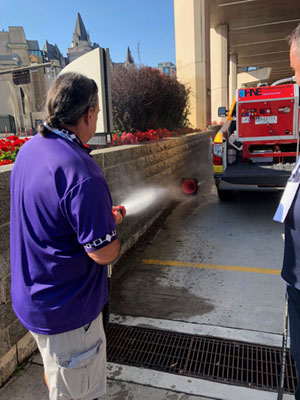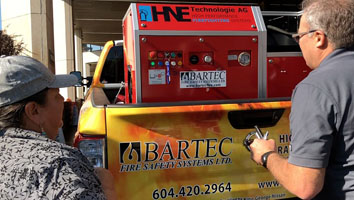|
|

|
  
Features
2018/11/7
First Nation
FIRE SAFETY IN FIRST NATIONS COMMUNITIES: THE WAY FORWARD
This story is brought to you in part by

Reporter: Teioshontathe Herne -
Researcher: Josée Dechêne -
Photos: Teioshontathe Herne -
Location: Westin Hotel Ottawa
There are over 630 First Nation Communities throughout Canada, making up approximately 4.9% of the population (Government of Canada). Fire Safety is a big concern because each community has one of the following three: fire department, mutual aid agreement, or no fire protection at all. It is all dependent on the community's location. According to a 2016 fire statistic, First Nation Communities have higher percentages of fire incidence (2.4%), death due to fire (10.4%), fire injury (2.5%), and fire damage per unit (2.1%) than the national average.
In April 2016, WaterToday reported on the dire housing and fire protection situation in First Nation communities. At the time Blaine Wiggins, Executive Director, Aboriginal Firefighters Association of Canada (AFAC said that, "Fires on reserves typically cause multiple fatalities due to overcrowding. There is no housing code in many reserves. If houses were built to code, we would not be seeing the rates of fatal incidents we are seeing now."
While the lack of fire awareness and inadequate equipment contribute to the situation, housing - or the lack of adequate housing largely due to the absence of building codes and regulatory frameworks on reserve - is the root of the problem.
Yet, the Government of Canada (INAC) spends an estimated $280 million to support the housing needs of First Nations on reserve (of this amount, $152 million is provided by CMHC), and has earmarked $732 million over two years for 2016-17.
This sounds like a large amount, but according to First Nations across the country, it's not enough and it's spread too thin. The problems caused by inadequate funding are further exacerbated in remote and semi-remote areas of the country, where the accessibility of training and equipment is already limited.
Of the total amounts awarded for housing needs, Indigenous Services Canada (ISC) provides core fire protection capital funding to First Nations on an annual basis. First Nations prioritize their spending to meet the needs of their communities, including fire protection services. Fire protection services may include firefighting, operation and maintenance of fire halls, training, education, and purchase of equipment such as fire trucks.
From 2008-2009 to 2016-2017, ISC provided an average of $28.9 million for fire protection to First Nations across Canada, including: $10.4 million for capital investments (fire trucks, fire halls, etc.), $13.7 million for operations and maintenance of assets, and $4.9 million for firefighter training.
The fire safety situation in indigenous communities has not significantly improved since WaterToday reported on it in 2016, but there are signs of progress and hope. For one, in a June 2018 report, From the ashes: Reimagining fire safety and emergency management in Indigenous communities, the Standing Committee on Indigenous and Northern Affairs declared its support for the creation of an independent Indigenous Fire Marshal's Office (IFMO) in collaboration with First Nations.
The IFMO role will mainly be to coordinate and collect data on incidents in First Nation communities to support an incident reporting system. "Up until now we only had anecdotal information regarding fire injuries and fatalities," said Wiggins. While the federal government has stopped tracking collecting data regarding on-reserve fires in 2010, most of the data it collected pertained to capital assets and little attention was paid to investigating the cause and consequences of fire events, which is essential to preventing further tragedies".
Investigating fire incidents is a key component of prevention. If you know what caused the fire you can prevent it. In most aboriginal reserves, there is no robust reporting system. According to First Nations National Building Officers Association's (FNNBOA) president Keith Maracle, "Most of the reporting to INAC is of a statistical nature, related to the numbers of incidents and so on. There is no post-fire in depth investigative reporting"
According to Wiggins, AFAC is now in the process of implementing the IFMO and the office is expected to be up and running within a year in a half. The Association is currently meeting with First Nation communities to make sure each community has their say regarding the program and services offered by IFMO.
With regards to fire safety equipment innovation, our reporter, Teioshontathe Herne, attended the Canadian Association of Fire Chiefs Annual Education Conference held in Ottawa in September. While there were exhibitors representing every sector of the fire service industry from equipment and communications technology to training and publications, Herne was particularly taken by the Bartec fire safety Systems' products, which its owner demonstrated right there in the Westin parking garage.
Bartec Fire Safety Systems is a company based in British Columbia, Canada. The Founder and President of the Company, Robert Barrett comes from a family of firefighters and with that in mind he has developed products that are "environmentally friendly and designed for the average person". Bartec has a wide array of products including fire extinguishers, MFU (Mobile Fire Unit), and DSPA (Dry Sprinkler Powder Aerosol).
The devices can be used by anyone in the community (as long as they know which buttons to push). This means that even the village elder is capable of using the products.
|
 > > |  |
CEO/Founder (Rob Barrett) showing two members of a First Nation community how to use the Mobile Fire Unit (MFU)
The fire extinguishers and MFU are both water-based, with a foam additive that is flame retardant. Barrett stated that "you put a fire out in a pulsing motion". Which means that you spray the flames then stop and as the foam expands it smothers the fire. "Both of the products are field rechargeable. All you need is water, compressed air, and a supply of foam, and you could go all day", said Barrett. More importantly, the MFU's exceptional efficiency reduces water consumption and chemicals to an absolute minimum.
The DSPA is another product that Barrett refers to as the "hand grenade". Once the cap is removed, it is then thrown into a fire, and the temperature of the fire is reduced immediately. These devices put out fires quickly and safely. Barrett said that in one instance "the fire chief had an MFU [on the back of his truck] and was able to put the fire out before the fire truck arrived at the scene. The only complaint about the product was that firefighters weren't getting a chance to put out fires.
Earlier that day, Rob Barrett had spoken to Larry Edgar who is the founder of MUTS, (which stands for Multi-use Trailer Systems) - a Canadian company based in Ontario that makes versatile ATV work trailers - about putting an MFU on one of his trailers. Barrett said, "it would be no problem to put the unit on the Trailer", he then added "the trailers were neat because skis could be attached to the wheels and the trailer could go virtually anywhere". According to MUTS' website, the trailers are "lighter, more maneuverable and more stable than the competition and yet can still handle a 2,000 lb. payload with ease, even in rough terrain". Which means that it will accommodate all types of terrain and seasons in First Nation Communities. This is ideal because it can be attached to snowmobiles, and ATV's.
These types of collaboration could be beneficial for first nation communities in increasing accessibility, cutting down the response time and decreasing the use of water and the time
|
|
|
Have a question? Give us a call 613-501-0175
All rights reserved 2025 - WATERTODAY - This material may not be reproduced in whole or in part and may not be distributed,
publicly performed, proxy cached or otherwise used, except with express permission.
|
|